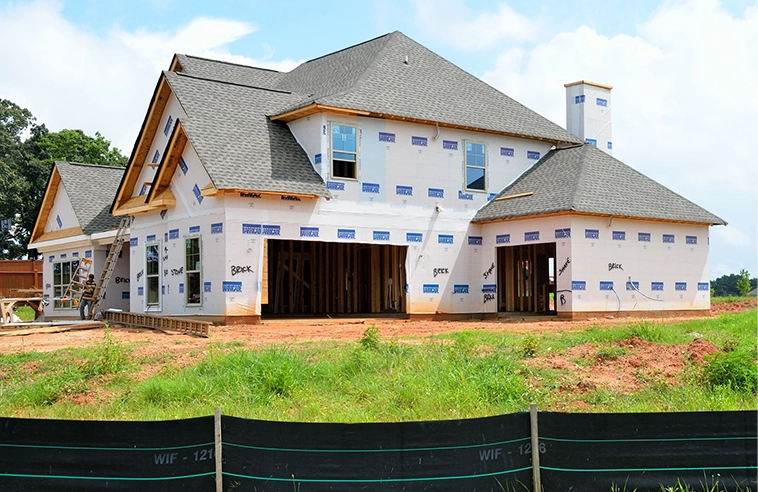11 Ways Your Construction Company Can Attract and Retain Workers
The labor shortage problem
We don’t need to tell you that hiring construction workers is a challenge and that the United States is plagued by a labor shortage. You live that reality. Associated General Contractors’ most recent Worker Shortage Survey found that 80% of construction firms — from small businesses to huge companies — are having a hard time filling craft positions and 57% are having a hard time filling salaried positions. (The survey was conducted in 2019. The pandemic probably hasn’t improved the situation.)
The construction workforce is aging and not enough young people are joining the industry to replace those who are retiring. In this chart from The Center for Construction Research and Training, you can see how the share of the workforce aged 34 and under has decreased from about 50% in 1985 to under 40% in 2015. At the same time, those aged 45 and over has increased from less than 30% of the workforce to about 40%.

What can you do to increase your chances of hiring — and retaining — construction employees? This article gives 11 ideas. You’re no doubt already doing some of them, but we hope you find something new to try. Let us know if there’s something you’ve had success with that’s not on this list!
11 possible solutions to help you hire and retain construction workers
1. Attract talent from high schools and colleges
Find out when the career fairs are held at your local high schools and community colleges and set up booths. If you have a diverse staff, try to have that reflected in the employees you pay to staff your booths at the fairs. Many young people are aware of the value of workplace diversity and it’s attractive to them.
Schools sometimes have work experience programs so students can visit workplaces. Be proactive about getting involved.
Are you able to offer summer jobs or paid internships so high school students can get an insider look at the trades before they make a longer term commitment?
According to Associated Builders and Contractors’ 2021 Workforce Development Survey of its members, 30% participate in internship programs. Of contractors specifically, 60% of them participate in internships for craft/trade jobs, while 59% participate in internships for project management.
2. Get involved with organizations that work with youth
Here are three organizations that work with young people, fostering their interest in construction, engineering, architecture, and the trades.
ACE Mentor Program“Founded in 1994, the ACE Mentor Program of America (ACE) is a free, award-winning, afterschool program designed to attract high school students into pursuing careers in the Architecture, Construction and Engineering industry, including skilled trades…
Over 10,000 students participate annually, drawn from approximately 1,100 high schools…
More than 4,100 volunteer industry professionals mentor student teams through a 35-hour-long simulation of designing and constructing a project.”
YouthBuild“Students learn job skills in construction and in other high-demand employment sectors such as manufacturing, healthcare, tourism and hospitality, retail, and information technology. They also learn and refine soft skills such as teamwork, problem solving, communication, and adaptability.
To date, more than 180,000 YouthBuild students worldwide have built more than 35,000 units of affordable housing and other community assets such as community centers and schools.”
Build Your Future“Our mission is to inspire, recruit and train the future generation of craft professionals while shaping positive perceptions of the construction industry…
We work to equip the industry with the education and resources needed to effectively reach students, veterans, families and educators, as well as provide information about the industry and promote careers in construction.
We can’t reach those goals without you – industry representatives are key to building a pipeline of skilled craft professionals.”
3. Offer a signing bonus
While a signing bonus is unlikely to be a huge factor in a potential employee’s decision, it could tip the scales in your favor if they’re deciding between your company and another. Make sure the bonus is payable only after a certain amount of time on the job. (You don’t want someone to sign up, grab the bonus, and leave!)
4. Keep a file of previous applicants
Don’t forget about people who applied for your jobs in the past. Perhaps they weren’t the right fit a year ago, but now they have a little more experience, they may be perfect. Get in touch.
5. Use social media
Like it or not, social media is important. Even if you don’t get a lot of interaction on your posts — and some days you may wonder why you bother — potential hires will check out your social media profiles. You don’t need to be on every social media platform, but you do need to have a presence on at least one or two. At a bare minimum, if you’re starting from scratch on social media, create a company page on LinkedIn.
Then, if you want to make videos (which people love!), you should be on YouTube. Otherwise, Facebook is a good choice. Even though your parents (maybe even grandparents) have Facebook accounts, don’t dismiss it as ‘only for old people’. The largest group of active Facebook users are 25 to 34 years old.
Here’s an article that goes into more detail about the ages of people who use different social media platforms:Social media demographics to inform your brand’s strategy in 2021
6. Have a good website
Just as a potential hire will look at your social media profiles, they’ll also check out your website. If it looks like it was built in 1997, that’s not going to give a good impression.
Make sure it’s functional, looks good, is relatively up-to-date, and is mobile friendly.
7. Foster and showcase a great company culture, including safety and diversity
Culture matters to potential hires, as well as to current employees. On your social media profiles and your website, showcase the diversity of your current employees, perhaps with interviews that include photos or videos. A potential hire might visit your website or your social media account only once — make it count.
Safety is important to everyone. On social media and your website, blow your own horn about your great safety track record.
Of course, your current employees are more likely to stay if you develop and/or maintain a healthy company culture that includes fostering diversity and inclusion. Inclusion means that you don’t just hire minorities and women, you listen to them, pay attention to their professional contributions, and make sure you’re being fair when it comes to promotions and pay increases. (How exactly you do this is obviously a whole topic in itself.)
In fact, it’s important to actively listen to all your employees, checking in with them to make sure they feel safe, supported, and appreciated, and that their skills are being put to good use.
8. Showcase technology
What technology does your company use? 3D modeling? GPS? Drones? IoT? Whatever it is, it can help improve the image of construction. You know it’s not all hammers and nails and manual labor, but potential hires may not be aware of how prominent technology is at your firm. Use your website and social media to show them the tech you use.
9. Institute a referral program
Consider giving current employees a bonus for each person they send your way whom you hire and who makes it through the probationary period.
10. Improve your benefits package
Obviously, higher pay makes you more attractive to potential hires, but if you can’t offer higher wages, can you provide better benefits?Here are some findings from Aflac’s 2020-2021 WorkForces Report on construction industry trends:
- 31% of construction industry employees say improving their benefits package is the one thing their employer could do to keep them in their jobs – second only to increasing their pay.
- 76% of construction industry employees expect at least one expanded benefit, including supplemental insurance or telemedicine options.
- 69% of construction industry employers reported that supplemental insurance improves employee recruitment.
- 65% of construction industry employers reported that supplemental insurance improves retention.
11. Offer flexibility
Another attractive feature that doesn’t involve higher wages is being as flexible as possible. Does the whole crew really need to be on-site for the same eight hours, Monday to Friday? Scheduling software makes it a lot easier to accommodate different hours.
In the recent webinar, Navigating the Labor Shortage, Dudley Harris at Bay Electric Co. Inc. says that his company now tends to get more applicants for part-time positions than for full-time positions. So keep that in mind. You might have better luck hiring two part-time workers than one full-time worker.
Same goes for short-term work. Some people, including those who work in offices, prefer to work as contractors on a series of short-term projects, rather than making a long-term commitment.
*If you’d like to learn more about our warranty management services, please contact Matt at (316) 706-0368 or matt@prohome.com today.
If you know someone who’s hiring construction workers and might find this information helpful, please share it with them.




